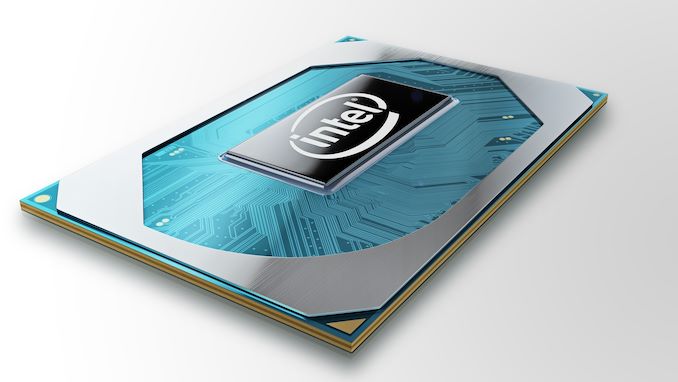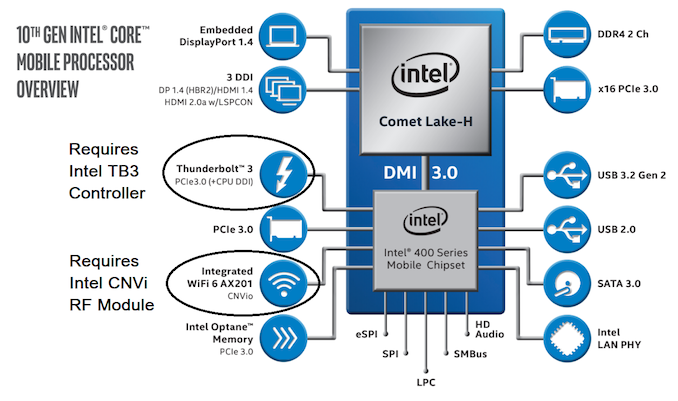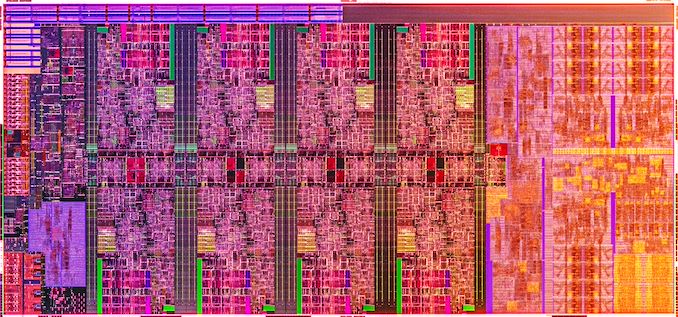Intel Details 10th Gen Comet Lake-H for 45 W Notebooks: Up to 5.3 GHz*
by Dr. Ian Cutress on April 2, 2020 3:01 AM EST
Two of the big announcements out of CES this year were both mobile related: Intel and AMD announced they would be launching new gaming laptop processors into the market in the first half of this year. 45 W parts, also known as H-series in the business, provide the basis for productivity and gaming notebooks that use additional graphics to give some oomph. These systems span from thin and light with GPU requirements, through ‘luggables’ that are just about portable, all the way up to desktop replacement designs. Intel’s newest 10th Gen H-Series are based on the Comet Lake family, the fifth iteration of Intel’s 14nm Skylake designs, and they’re going all the way up to 5.3 GHz*.
The new CPU list from Intel starts with the Core i9-10980HK at the top, with eight cores, sixteen threads, and all the focus is on that 5.3 GHz turbo frequency.
*This CPU can hit this frequency on two cores. However this has some specific requirements: the system needs to be within its secondary power limits, and Intel’s Thermal Velocity Boost also needs to be turned on. The latter of which means that there has to be additional thermal headroom in the system, and that OEMs have designed for this and enabled it within the system. This allows the CPU to go from 5.1 GHz to 5.3 GHz. Every Intel Thermal Velocity Boost enabled CPU requires specific OEM support in order to get those extra two bins on the single core frequency.
The base frequency of this chip is 2.4 GHz, and it has a regular 45 W TDP (sustained power), which can be run in cTDP up mode for 65 W. Two other plus points on this chip is that it is unlocked, for when an OEM provides more thermal headroom, and it supports DDR4-2933, which is an upgrade over the previous generation. Intel's recommended PL2 (turbo power) for the Core i9 is 135 W, and Intel says the recommended 'Tau' is set to 56 seconds for the i9, and 28 seconds for all the other CPUs. OEMs don't often adhere to these values for notebooks, but they are provided as a guide. It does mean that in order to hit 5.3 GHz, the Core i9 is by default allowed to take 135 W across two cores, or 67.5 W per core. Even at 60W per core, you're looking at 50A of current per core... in a laptop.
| Intel 10th Gen Core 45W Processors (Comet Lake-H) |
|||||||
| AnandTech | Cores Threads |
Base Freq |
Turbo Freq*1 |
Turbo Freq*2 |
DDR4 | TDP | cTDP Up |
| i9-10980HK ++ | 8 / 16 | 2.4 | 5.1 | 5.3 | 2933 | 45 W | 65 W |
| i7-10875H | 8 / 16 | 2.3 | 4.9 | 5.1 | 2933 | 45 W | - |
| i7-10850H + | 6 / 12 | 2.7 | 4.9 | 5.1 | 2933 | 45 W | - |
| i7-10750H | 6 / 12 | 2.6 | 4.8 | 5.0 | 2933 | 45 W | - |
| i5-10400H | 4 / 8 | 2.6 | 4.6 | - | 2933 | 45 W | - |
| i5-10300H | 4 / 8 | 2.5 | 4.5 | - | 2933 | 45 W | - |
| *1 Turbo Frequency for devices without Thermal Velocity Boost *2 Turbo Frequency for devices with Turbo Max 3.0 and Thermal Velocity Boost ++ Unlocked CPU + Partial Unlock |
|||||||
Intel only has a single Core i9 at the top, with the top grade i7 also getting 8 cores, but only up to 5.1 GHz and no overclocking. The Core i7-10850H is going to be the second exciting part over the i9, with six cores and a 5.1 GHz turbo, but it allows an additional 4-bin overclock on the first two cores where thermals allow. All of the CPUs here are listed as 45 W, and all support DDR4-2933 memory (up to 128 GB we believe). Due to Intel Thermal Velocity Boost, all the i7 and i9 parts are +200 MHz above what they would be without the technology, with frequencies that we are more used to seeing on the 9th Generation.
Intel states that there will be 30+ designs using the new 10th Gen Comet Lake-H that fit within the ‘thin and light’ profile of 20mm, and 100+ designs in total across consumer, commercial and workstation. Intel is keen to highlight that it is the only CPU vendor that has OEM partners that provide HDR1000 panels and 300 Hz refresh displays in this market.
Intel also made a big fuss about TB3 support, although it isn’t native here – you still require a controller. One positive for 10th Gen is that it supports two TB3 controllers, rather than previous generations that only supported one. Though again, it depends on whether the OEM puts it in their system, because it isn’t native to the CPU.
We’re not going to post Intel’s benchmarks here, because to be quite honest they are not comparable. In gaming tests, Intel compares a 10980HK equipped with a RTX 2080 Super to a 7820HK equipped with a GTX 1080. As a result, a lot of difference in the gaming performance is going to be in the GPU, but also the graphs that they showed did not start at zero – suggesting that the graph somehow doubled despite only rising 44% in a select test. We’re going to wait to see for ourselves what the hardware can do.
Intel did show a die shot of the silicon, with all of its eight cores. It looks strikingly similar to the Coffee Lake 8-core silicon, because it’s practically identical. If there are any changes, it is minor, and then the chip is binned for the voltage profile.
Meanwhile, although none of Intel’s partners were named or otherwise involved in Intel's own announcement, they have been holding separate briefings regarding their laptop plans. MSI, Lenovo, Acer, and others are all releasing 10th Gen laptops as soon as April 15th, with the rest to follow in May. Broadly speaking, expect to see many vendors update existing 9th Gen gaming systems to include 10th Generation parts, though in the case of gaming laptops we're going to see the occasional, more substantial update to take advantage of NVIDIA's new hardware and thermal capabilities.
Intel’s competition here is going to be the recently launched Ryzen Mobile 4000 processors, in devices like the ASUS Zephyrus G14 and the Dell G5 SE. These new APUs were launched on 1st April, however unfortunately we were not told of an embargo change, and still expected the launch to be another two weeks later. We’re aiming to get our review out next week. When we get access to Intel’s 10th Gen H-series, we will compare it against AMD as well.














157 Comments
View All Comments
duploxxx - Thursday, April 2, 2020 - link
And it is running a Microsoft OS, so there are Always multiple things on the cpu scheduler…This is just another fool the benchmark - marketing trick from Intel. There 14nm and current X times refreshed core design is not capable of handling 8 cores in a low TDP package. After several revisions and flaw fixes its back at the Pentium burst era. Where ghz is needed for higher performance which always results in heat.
schujj07 - Thursday, April 2, 2020 - link
The Intel Core architecture has only been efficient a 4c or less and clock speeds 4.0GHz or less. Just look at the difference in power draw between the i7-4770k (84W TDP) and i7-4970k (88W TDP). At stock clocks figuring max boost for 1T, at 3.9GHz the 4770k uses 14.76W where as at 4.4GHz the 4970k uses 32.58W. To get that extra 500MHz requires a massive 120% increase in power. At 8T they use 67.09W & 88.67W respectively. Yes that is on the 22nm process, but the absolute core power draw isn't any much better on 14nm. For 1T going 4.5GHz on i7-7700k is 26.29W, a drop of 20% compared to 14nm. 8T between the 7700k & 4970k is almost equal in power draw 91.36W vs 88.67W.close - Thursday, April 2, 2020 - link
There is a point where doing the work faster is a lot more efficient, where you have the best performance per Watt. Anything else either produces less work, or does it in more time, or uses more energy to do so.Nokiya Cheruhone - Saturday, April 4, 2020 - link
Read a little about the dirac distribution. This point is not reached as the actual energy consumption per calculation is an exp(freq).imaheadcase - Thursday, April 2, 2020 - link
Since when is heat output matter at all when it comes to performance. No one goes "oh know i see my laptop is making more heat, sucks that i'm getting more performance though because of it". lolIrata - Friday, April 3, 2020 - link
If your laptop generates more heat, i.e. uses more energy this means both reduced battery run time but also that the CPU will throttle, so actual performance will be reduced.It will also mean that your laptop and power brick will need to be larger and heavier. Add a high end dGPU to that and either it or the CPU cannot run at full performance since the cooling solution needs to handle the heat of both.
Better performance / watt means that all components can run at a higher sustained speed.
philehidiot - Friday, April 3, 2020 - link
I'm passing up ordering food to allow you all to bask in my wisdom here. Be grateful (or just absolutely lay into my arguments as usual...). There are other issues with a high power draw laptop - I used a DESKTOP Pentium 4 laptop. A few things were evident. It was several kilos for a start and what was due to the huge heat sinks required. This meant a lot of space was required so the thing was very thick. Then you had about 5 or 6 fans in it if I remember rightly and those mostly sucked in from the base. So you couldn't put it on your lap without cooking the laptop. Also the heat output was such that it was very unpleasant to use in summer due to the palm rest areas getting just so hot. And then we get to the fact that it gradually cooked itself. These high temperature devices eventually fry themselves due to the heating and cooling cycles eventually breaking something. Mine had several parts fail bit by bit and finally became unusable.So yes, people can be very happy with a hot running laptop. But if you use it on your lap, you'll end up with a blistered penis.
Cullinaire - Saturday, April 11, 2020 - link
You are ordering polish dogs for lunch I take it?Namisecond - Saturday, April 4, 2020 - link
It matters for mobile devices when the CPU hits its throttle temps and actually gives lower not much greater performance for the power consumed...also, if your laptop is on your lap, and it suddenly gets scaldingly hot.schujj07 - Thursday, April 2, 2020 - link
Your example also forgets about the extra power draw for that instance. While it might not heat up instantly, you have to be able to send that massive amount of power required to do it as well. As was stated by Ian "t does mean that in order to hit 5.3 GHz, the Core i9 is by default allowed to take 135 W across two cores, or 67.5 W per core. Even at 60W per core, you're looking at 50A of current per core... in a laptop."